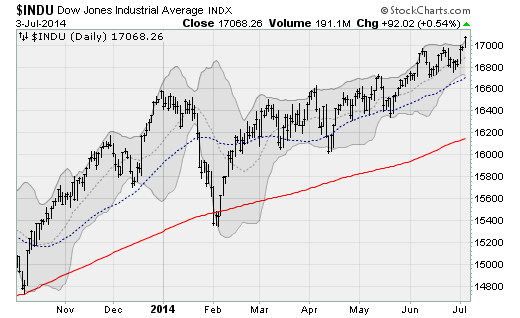Why the smoking-hot Dow could cool quickly
A better-than-expected jobs report sent stocks soaring on Thursday, pushing the Dow Jones industrials above the 17,000 for the first time ever -- a level the index has been pawing at since early June.
The catalyst was a 288,000 jump in private non-farm payrolls and a drop in the unemployment rate from 6.3 percent to just 6.1 percent. That continues the best string of job gains seen since the height of the dot-com excitement back in the Clinton Administration.
With investor sentiment and positioning already extended, and with the market suffering no significant pullback since 2012, predictions are flying about where the Dow is headed next. One thing is certain, if the market maintains the current momentum (the Dow gained 268 points in this shortened week from Monday's lows), we could see Dow 18,000 by mid-July.
University of Pennsylvania finance professor Jeremy Siegel thinks we can do better, pointing to the potential for Dow 20,000 by year-end. Bullish Wall Street analyst Laszio Birinyi believes the market can jump roughly another 6 percent by that point, taking the Dow to around 18,100.
Taking the opposite tack is Yale professor Robert Shiller, who has authored two editions of his "Irrational Exuberance" title warning about both the dot-com and housing bubbles. He's noting that after adjusting corporate earnings for the vagaries of the business cycle, stocks have rarely been more expensive. In fact, current valuations have been exceeded only in 1929, 2000 and 2007.
Shiller could be onto something given the blemishes I'm seeing deep within the market.
For one, buying interest has been very narrow, with a thin subset of the market is participating in the upside. It's not a hard and fast rule, but generally this is associated with a market that's in need of a washout to lower prices and regenerate broad interest in stocks. On Thursday, just 478 stocks advanced on the New York Stock Exchange. That's well off of highs of 1,000+ seen in late June and a peak of 1,750 in early June.
Another problem is the weakness that's hitting the bond market, with Treasury bonds selling off hard this week. That's pushing up long-term interest rates in a way that hasn't happened since November.
A couple of things are in play here. For one, as the unemployment rate nears the Congressional Budget Office's estimate of "full employment" -- now pegged at 5.8% -- inflationary pressures will likely build. That weakens bonds because inflation eats away at the real return to investors. So, prices drop in sympathy.
Also, a tighter job market and higher inflation will put pressure on the Federal Reserve to tighten monetary policy. Not only is the ongoing QE3 bond-buying program on track to end in October, but with the job market's recent strength, the chatter is increasing that short-term interest rates could be hiked sooner than Wall Street expects. Remember, short-term rates have been near zero percent since 2008.
The rise in interest rates has already hit yield-sensitive utility stocks, with the Utilities SPDR (XLU) dropping 4.2 percent. If that continues, the broad market could get hit as investors start worrying that higher rates could pinch the housing market and consumer spending.
Moreover, much of the leadership for the stock market's latest advance is from areas like semiconductors that are now looking very extended. The Market Vectors Semiconductors (SMH) is up nearly 16 percent since mid-May and has basically gone vertical. The separation between the SMH and its 200-day moving average has increased to levels associated with reversals in the past.
And finally, it's worth noting just how complacent the market feels right now. One way to measure this is to look at how stocks have shown a tendency to close higher on the last trading day of the week. This is a sign of confidence because investors are essentially buying on the expectation nothing negative will happen over the weekend.
Currently, the market has followed this pattern for seven consecutive weeks. Going back to the 1990s, additional gains were seen only one other time -- in late 2010 with the run stopping at 10 in November of that year. In November 2013, September 2012, October 2005, December 1998 and October 1996, the run ended after seven.
This suggests that some near-term selling pressure could materialize as soon as next week -- which just so happens to coincide with the start of the second-quarter earnings season.



